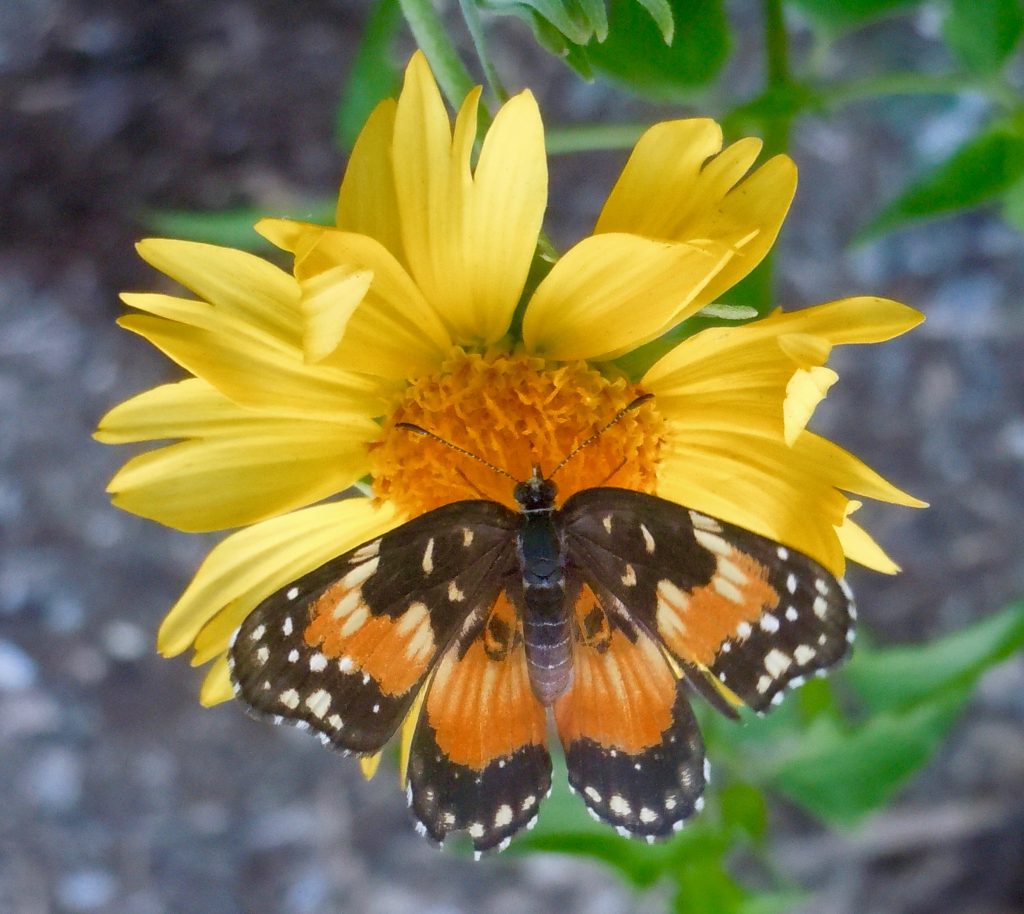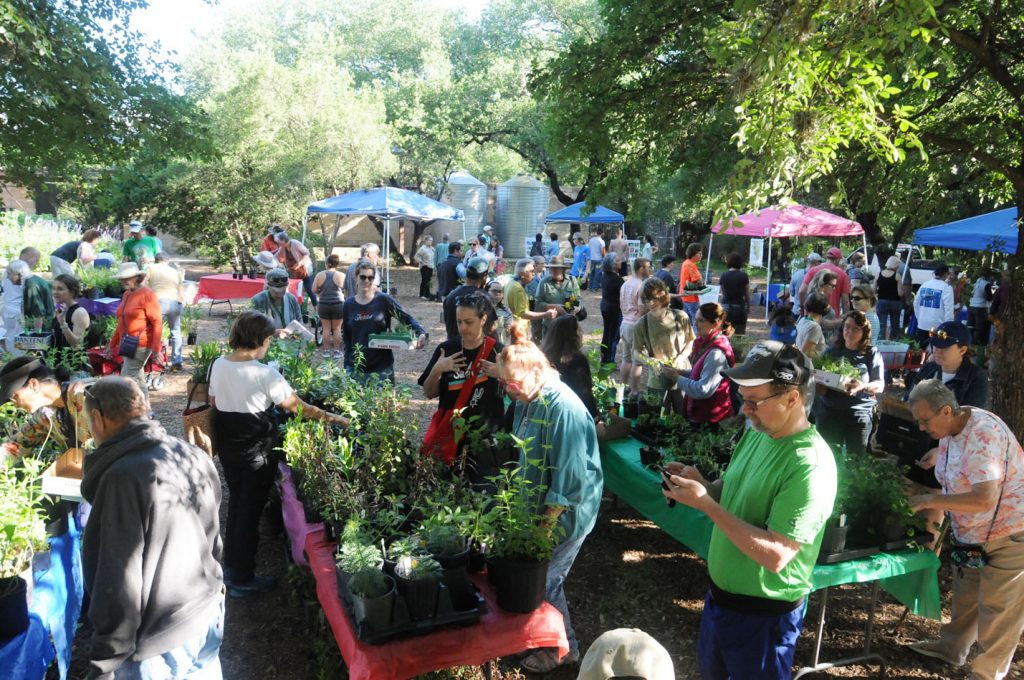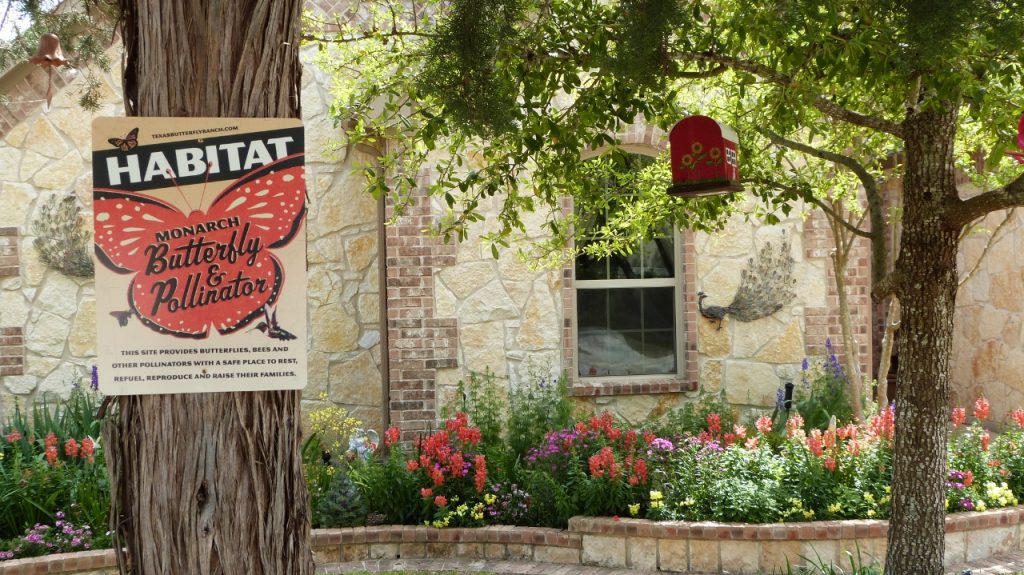Recent rains and a campaign to get Cowpen Daisies into area gardens as San Antonio’s “unofficial” pollinator plant of the year appear to have spawned an early crop of Bordered Patch butterfly caterpillars in the Alamo City.
A mound of Chlosyne lacinia caterpillars appeared early this week on Cowpen Daisies along the San Antonio River and around town. Typically, we don’t see the petite orange, charcoal and gold flyers in our urban gardens until later in the season.

On the San Antonio River near downtown: Bordered Patch caterpillars. Note the weird wide silk web. Photo by Monika Maeckle
As members of the Nymphalidae family, Bordered Patch rank as the most abundant member of their genus, found from the southern United States to Bolivia and Argentina.
Unlike their more celebrated monarch butterfly cousins, which lay their eggs one at a time, Bordered Patch lay up to 500 eggs in one heap. They host on sunflowers, nettles, verbenas and yes–Cowpen Daisies. “I’ve got them on Frostweed and sunflowers,” said Drake White of the Nectar Bar. “Glad I have the Cowpen Daisy covered.”
After a few days, the mound of yellow eggs turns dark, then they hatch into yellowish caterpillars. As they devour the leaves of their host plant, they darken and show harmless charcoal black bristles on a dark orange background. The gregarious feeders create intriguing mounds of life on the plants that feed them and leave skeletonized foliage riddled with silk webbing in their wake.

Bordered Patch butterfly on Cowpen Daisy, San Antonio’s “unofficial” pollinator plant of the year for 2019. Photo by Monika Maeckle
According to a 1970 paper by Drummond and Emmel, the yellow larvae of the egg masses hatch simultaneously. The tiny caterpillars consume the empty eggs, then start feeding on a thin silken web in a packed mass on the underside of the host plant leaf.
“When disturbed, first and second instar larvae frequently will begin a synchronous jerking movement of the body. The function of the web is not known, but it may possibly help to maintain colony unity and protect the larvae from some predators and parasites.”
The life cycle from egg to butterfly takes 35-45 days, depending on conditions, and includes a pearly, black speckled chrysalis that can vary greatly in appearance.
For an excellent photographic blow-by-blow of the process, see Jan Dauphin’s Bordered Patch life cycle study.
Cowpen Daisy sells out at NPSOT plant sale
The Native Plant Society of Texas San Antonio (NPSOT) chapter staged its Bexar Roots Plant sale last weekend. Top sellers? Native milkweeds and Cowpen Daisies.
According to organizers, the sale was the most successful ever, placing more than 1,700 native plants with local gardeners–twice the usual volume. “A lot of well-informed people

Biggest plant sale ever for NPSOT-San Antonio last weekend. Photo by Andrew Awalt
shopping with their plant lists and hungry for native plants” showed up, said Joan Miller, San Antonio NPSOT board member and sale organizer. Few plants were left after the three-hour event, she said.
300for300 Pollinator Habitat Campaign 20 percent over goal
The 300for300 pollinator habitat campaign we launched last spring to create 300 pollinator habitats for San Antonio’s 300th birthday has exceeded its initial goal by more than 20 percent. As of May 1, 2019, 300for300 lists 362 pollinator gardens pledged.
The 300for300 campaign aimed to help San Antonio make good on a promise to the National Wildlife Federation (NWF).
As the nation’s first Monarch Butterfly Champion City under the NWF’s Mayor’s Monarch Pledge, San Antonio committed in 2015 to stage a community wide pollinator gardening initiative as one of 24 action items. Since the City celebrated its Tricentennial in 2018, we figured creating 300 new pollinator gardens for San Antonio’s 300th birthday made sense.
To make it less daunting, we set a goal to inspire 30 pollinator habitats in each of our 10 city council districts, which made the challenge seem more achievable. That’s why the map above shows pollinator habitats coded by city council district.
By the end of 2018, we had 325 pledged; today, we register 362 on the roster. If you’d like to join us, sign up here. We update the map once a month.
While 300for300 started as a local campaign, it has since grown to include pollinator habitats in California, Laredo and Round Rock, Texas. Several readers have shared photos of their installations and the pollinators who now frequent their yards.

Reader Candy Roach sent us an email last July just as she was beginning her pollinator gardening effort. “The plants are finally starting to bloom and we’re seeing mostly Queens and Swallowtails right now along with a wide variety of bees and wasps,” Roach said. “By next year I hope the plants start to take off and enjoy their new home.”
She sent an update last week that included the photo above. To Roach and other pollinator gardeners, keep up the good work!
Want to add a sign to your pollinator habitat like the one in Candy Roach’s garden above? Check out our shop.
TOP PHOTO: Bordered Patch caterpillars on Cowpen Daisy in a downtown San Antonio garden this week. Photo by Monika Maeckle
Related posts:
- Popularity of pollinator gardens growing in areas prone to drought
- Planting a butterfly garden? Here’s tips on how to do it
- Mostly native butterfly garden outperforms lawn every time
- A year in the life of an urban butterfly garden
- Downtown River walk plot converts to pollinator garden, creature haven
- Converting your Lawn to a Butterfly Garden
- San Antonio becomes first National Wildlife Federation Monarch Champion city
- Tropical Milkweed: To Plant it or Not is No Simple Question
- How to raise Eastern Swallowtails
- How to raise Monarch butterflies at home
Like what you’re reading? Don’t miss a single post from the Texas Butterfly Ranch. Sign up for email delivery, like us on Facebook, or follow us on Twitter, @monikam.


Transplanted cowpen raises today. Hope the beautiful bordered patch butterflies find them!
I would like to be apart of the 300for300 registry but live in Bell Co. Would I be able to be registered too? If yes, please let me know how. Thank you
Of course! Butterflies without Borders. Sign up here: https://texasbutterflyranch.com/pollinator-habitat-sign-up/
So proud of my wife Monika and her Texas Butterfly Ranch, which has connected and educated so many of us and inspired us to adopt new landscaping and gardening practices, and above all, go native. -RR
If you plant sunflowers or coneflowers, they will find them too. And strip them.